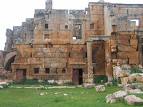 The Dead Cities are a group of 700 abandoned settlements in northwest Syria between Aleppo and Hama. They date back to before the fifth century B.C and contain many remains of Christian Byzantine architecture. Important dead cities include Qal'at Sim'an, Serjilla and al Bara.
The Dead Cities are a group of 700 abandoned settlements in northwest Syria between Aleppo and Hama. They date back to before the fifth century B.C and contain many remains of Christian Byzantine architecture. Important dead cities include Qal'at Sim'an, Serjilla and al Bara.
Chris Wickham, in the authoritative survey of the post-Roman world, Framing the Early Middle Ages(2006) argues that these were settlements of prosperous peasants which have few or no specifically urban features. The impressive remains of domestic architecture are the result of the prosperity of peasants who benefited from a strong international trade in olive oil at the end of Antiquity.
 The other arguments are that these were prosperous cities that flourished as they were located along major trade routes in the Byzantine Empire, and not merely prosperous peasant settlements. When the area was conquered by the Arabs, the trade routes changed and these towns lost the majority of the business that their economies depended on. The settlers eventually abandoned their towns and headed for other cities that were flourishing under the Arabs and the Umayyads as increasing urbanisation took its toll.
The other arguments are that these were prosperous cities that flourished as they were located along major trade routes in the Byzantine Empire, and not merely prosperous peasant settlements. When the area was conquered by the Arabs, the trade routes changed and these towns lost the majority of the business that their economies depended on. The settlers eventually abandoned their towns and headed for other cities that were flourishing under the Arabs and the Umayyads as increasing urbanisation took its toll.


